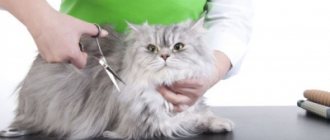8644Administration
The birth of a pet has always been a very important event. In order to avoid various complications and unforeseen situations, you need to prepare for them in advance, and for this you need to know how the cat behaves before giving birth.
It all starts not from this, but from one to three days after a successfully completed mating. It is easy to catch this moment if it was controlled and much more difficult if the cat became pregnant on its own. In any case, it is necessary to understand what is happening in order to take all necessary measures in a timely manner.
© shutterstock
A healthy cat experiences pregnancy and childbirth quite calmly and behaves very restrainedly, not particularly requiring help or other intervention. Complications can occur in small cats, as well as in purebred cats and those in poor health. Some cats may vomit before giving birth. In developed countries, childbirth is carried out under the supervision of a special doctor, but in our country, owners are forced to help their cat themselves.
What happens to the animal
In order to know when your pet will give birth to kittens, you need to closely monitor her, especially in the last weeks of pregnancy. But the main signs appear about a few days before this process. Severe pain begins in the uterine area, and such pain can also occur if labor begins a little earlier or if a rejection process has occurred, that is, a miscarriage. When the animal’s pregnancy proceeded normally, the birth process will go very quickly, without complications. In order to help your pet give birth normally, you need to know how cats behave before giving birth and what happens to them at this moment.
The very first signs are a mucus plug, it comes out first, but it is very difficult to see, since this happens when the cat went to the toilet. She also begins to lick herself very often, but many also do not pay attention to such a trifle, since animals lick themselves quite often. Well, the last sign is contractions. They can be noticed without palpation. And then somewhere, half an hour later, the first kitten appears. Also, before the babies are born, the expectant mother may develop a fever and begin vomiting. At this time, the body is experiencing a strong emotional shock, so do not worry, as this is a natural process.
How does the feline birth process work?
Cats bear offspring for about 64 days, in rare cases - up to 70 days. On average, there are 3-5 kittens in a litter, but cases of the birth of eight cat cubs have been recorded. The duration of labor is influenced by several factors: age, number of fetuses, number of previous lambings, breed, diet during pregnancy. On average, the process of childbirth in cats takes from several hours to a day and a half, and includes periods of contractions, pushing and expulsion of the fetus.
The cat's first contractions may be invisible to others because they are still weak. At this time, your pet can be busy arranging the nest. As the contractions intensify, the cat may moan, meow, and its body periodically tenses in efforts. Then the cervix opens, the mucous birth plug emerges through the birth canal, followed by the first kitten.
Kittens are born “in order”, usually with a break of half an hour to 12 hours. Their birth may alternate with the expulsion of the placenta, which the cat sometimes eats. Kittens are born in the embryonic membrane (amniotic sac), the cat chews it, licks the cub, then bites the umbilical cord. The mother can begin feeding already born kittens in between contractions.
If your pet ignores the newborn kitten, the owner present at the birth will have to open the amniotic sac himself, carefully wipe the kitten and place it next to the mother. During the birthing process, your cat may need several hours of rest.
It is difficult for an inexperienced cat owner to understand whether all the kittens have already come out, or whether this is a break in childbirth. Even an ultrasound scan performed during pregnancy does not always reliably determine the exact number of fetuses. You can focus on the signs of the end of the birth process
During the birthing process, your cat may need several hours of rest. It is difficult for an inexperienced cat owner to understand whether all the kittens have already come out, or whether this is a break in childbirth. Even an ultrasound scan performed during pregnancy does not always reliably determine the exact number of fetuses. You can focus on the signs of the end of the birth process.
Normal pregnancy process, stages and timing
In a healthy animal, the process of pregnancy and childbirth occurs without the need for intervention or assistance. In purebred, small, problem cats, childbirth may occur with complications. In more developed countries, there is a special profession - zooobstetrician, a specialist responsible for the favorable course of childbirth, preserving the life and health of the mother and offspring. In “our realities,” all responsibility falls on the shoulders of the owners and general veterinarians.
On average, a normal cat pregnancy lasts 60–65 days, but the period can vary by 7–10 days depending on the breed and body composition of the expectant mother. Conventionally, pregnancy is divided into 3 stages:
- Mating – 3 weeks: after mating, the cat experiences swelling of the mucous membranes of the genital tract, but this does not guarantee pregnancy. Clear signs are observed from the third week: Drowsiness, decreased appetite and activity.
- Requires affection and attention.
- Vomiting (no more than 3 times a day, no longer than 2-3 days).
- Distinct pigmentation of the mammary glands - from light to bright pink.
- An enlarged uterus, which can be detected by a veterinarian by palpation.
- 4-6 weeks: Rapid growth of the “babies” and “rounding” of the cat. By week 6, the amount of fluid in the uterus increases, and the kittens begin to make their first movements.
- Kittens can be “felt” when gently palpated.
- The cat eats and sleeps more, otherwise behaves as usual.
- 7–9 weeks: Kittens are actively moving. The movements are clearly visible to the naked eye, especially if the cat is sleeping.
- Swelling of the mammary glands, release of colostrum.
- Some cats have a whitish vaginal discharge, which is normal.
- Increased anxiety and making a “den”.
Important! “Nesting” is not observed in all animals. A cat with increased social activity will benefit from the foresight of the owners in arranging the place and assisting in childbirth. “Tethered cats” need to be monitored especially carefully; hormones and a “naughty” character can lead the animal to a “breakdown” and rash actions, which can lead to premature birth or abandonment of kittens.
How likely are complications?
Contrary to popular belief, in practice complications during childbirth are encountered quite rarely. But this statement does not apply to the owners of Persian and Siamese pets to the same extent: the frequency of birth pathologies in these animals is quite high. At least 99% of births in cats proceed as normal, without the slightest problem. Despite this, many owners prefer to show their pregnant pet to a veterinarian in advance. How justified is this?
Actually, this is a great idea. A veterinary examination during pregnancy is a good way to find out in time about any health problems in your pet. An experienced specialist is already able to determine the presence of kittens in the cat’s uterus by the 26th day of pregnancy using ordinary palpation.
When using ultrasound machines, a veterinarian can not only detect pregnancy very early, but also find out exactly how many kittens will be in the litter, and also have a high probability of identifying signs of congenital pathologies and deformities in unborn kittens. However, we can speak with certainty about their presence/absence only on the 45th day, since by this time the skeletal tissue of kittens hardens and mineralizes so much that it is clearly visible on x-rays. Some veterinarians do not recommend frequent ultrasound examinations. There is an opinion that frequent exposure to ultrasound can negatively affect the development of fetuses.
How to find out the due date of an upcoming birth with an accuracy of an hour?
If you want to know exactly when your cat is due to give birth, start measuring her body temperature about two weeks before her due date. It is necessary to take measurements every day, at approximately the same time. The temperature of all animals is measured in the rectum.
The tip of the thermometer must be lubricated with Vaseline or some thick baby cream. The measurement time is exactly three minutes. A cat's normal body temperature ranges from 38.5° to 39.5° Celsius. If you see 37.8° or lower on the thermometer, birth should be expected within the next 24 hours.
Less accurate (but slightly simpler) is a technique based on measuring the animal’s body weight. It is believed that during pregnancy a cat gains weight by about 20-25% compared to its original weight (this is subject to normal feeding).
If weight gain has stopped, then childbirth will probably happen in the near future. Of course, this technique is not very accurate. In addition, an increase in body weight by 20-25% is observed only in the case of a normal, balanced diet. More often than not, owners greatly overfeed their pregnant pet, causing her to become very fat. Remember that you should never do this!
Obesity is an almost 100% guarantee of problems during childbirth.
Animal behavior
When we know exactly how the animal behaves before the birth process begins, we will be able to properly help her. It is important not to miss this moment, and about a week before the kittens appear, carefully monitor your pet.
In addition to natural signs, changes in the behavior of the expectant mother also appear. In severe pain, she can arch her back, and is always close to her owner. It is important to have time to prepare a place for the cat to give birth; if this is not done in time, she will try to make a nest herself. And when it is ready, the animal will attract your attention and lure you to its nest for help.
“Therefore, it is very important to know at least the approximate time of birth and always be close to your pet.”
Indifference
The more common reaction of cats to the pregnancy of their owners is behavior without any changes. As a rule, they write about the extraordinary actions of animals and much less often talk about their ordinary habits. However, many cat owners note that their cats show no interest at all in the pregnancy of their owners.
However, can cat owners who show no behavioral changes feel pregnancy? At a minimum, they catch the smell, but perhaps the animal does not correlate it and other changes in its owners with pregnancy, or this phenomenon does not interest them.
The cat is shaking before giving birth - what could it be?
In this situation, there are several options:
- It is known that before the onset of labor, cats breathe faster, so much that it will seem to you that she is trembling and cold.
- Yes, the cat is really shaking. But if there are no more bad signs, then there is no need to worry, since during contractions there may be temperature changes. But if strong discharge begins or the animal is already very weak and loss of consciousness is observed, then it is better to consult a specialist, as this is an indicator of a complicated birth.
Signs of imminent labor
Vivid signs of imminent labor in a cat appear both 1-2 hours before the immediate onset of labor and the day before it. All this depends on the individual characteristics of the body. In primiparous animals, the precursors are noted earlier, since the body needs more time for the restructuring process. Signs of imminent labor in a cat are as follows :
- lack of appetite - the cat drinks a lot and consumes small amounts of liquid food, such as milk and broth. This is the first sign of the body preparing for childbirth;
- lethargy – the pet spends almost all its time in the birth box. She doesn’t even go out for a walk if she has the opportunity;
- active movement of the abdomen, especially while the cat is sleeping - kittens move vigorously until the very beginning of contractions, taking a position in which birth will be as easy as possible. The movement may begin 2 days before birth if the kittens are large and there are many of them;
- active pouring of the genital slit area - the cat has vaginal discharge, which she constantly licks off, maintaining cleanliness, which is important for preventing infection of kittens. This sign of close birth in cats is somewhat blurred in hairless breeds;
- the cork comes out - if the owner notices it, it looks like sour cream of a white-pinkish color. After the plug has come out, labor will begin within 1-2 hours;
- reducing rectal temperature to 37 degrees, which helps prevent bleeding after childbirth and during childbirth;
- the arrival of colostrum - the cat’s nipples sharply swell and fill with colostrum. If you click on them, a white drop will appear;
- hunching, in which the cat screams or tries to hide - it appears 4-6 hours before lambing due to false contractions. Such contractions are the most obvious signs of impending labor in cats. They do not cause the uterus to dilate, but they finally prepare the kittens for birth, as well as the vascular system in the uterus, which must contract in a timely manner so that uterine bleeding does not begin after the kittens appear. It is easy to determine from false contractions that the period of real contractions is approaching, which does not last so long;
- breaking of water - in most cases this is the main sign of close real contractions. A cat's water breaks 1-2 hours before she begins to give birth, but in some females, the water may break immediately at the birth of the first kitten.
© shutterstock
From the moment the main signs of the approaching birth appear, the pet should be constantly in sight. In this case, it will not be difficult for the owner to understand that the cat has gone into labor. He will be able to make sure that the cat does not huddle in a place unsuitable for birth, in which both she and the kittens, due to the impossibility of controlling the process by the owner, may be in danger.
When will they find out?
To accurately determine if an animal is pregnant, you can consult a doctor. A specialist will tell you with 100% confidence whether you should expect kittens soon. Typically, veterinarians use the following methods to recognize pregnancy in cats:
- Palpation. An experienced doctor will determine whether a cat is pregnant already on the 15th day after sexual intercourse, simply by feeling her uterus through the abdomen. A little later, on day 30-40, the veterinarian will even be able to tell the owner the exact number of fetal kittens;
- Ultrasound of the uterus. The study is carried out no earlier than 15 days after mating with the cat, already at this short period the pregnancy will be visible. And on days 24-25 after fertilization, you can see the kittens’ hearts beating;
- X-ray. In this way, it is possible to determine whether a cat is pregnant no earlier than 40-45 days after mating, when the skeletal system of the kittens is formed;
- Donating blood for relaxin, a hormone produced by the placenta from the 20th day after fertilization. This is a kind of cat pregnancy test, which allows you to either confirm that the female will soon become a mother, or refute such an assumption. It is believed that an analysis of this kind should be carried out no earlier than 26-30 days after mating, otherwise the result may turn out to be false.
By the way, sometimes worried owners who have once heard about a pregnancy test for cats go to a regular pharmacy for a “human” rapid test. But the test for women shows an increase in a special hormone during pregnancy - human chorionic gonadotropin, which is not synthesized by the animal body, therefore, the result of the test performed on a cat will be incorrect.
How quickly do animals pick up these odors and do cats sense their owner’s pregnancy in the early stages? Every woman's body is different. The hormonal process and the production of external secretions may occur sooner and be more active for some than for others. You can read the stories of women whose cats, through their behavior, reported the owner’s pregnancy before she found out about it by doing a test.
Precursors of childbirth and symptoms of an imminent birth of a cat...
External manifestations of imminent labor are called precursors and are similar in dogs and cats.
- Animal behavior,
- lactation,
- appetite,
- frequent urination,
- prolapse of the abdomen,
- loop softening,
- thermometry.
A week before giving birth, the animal’s behavior changes
. This is due to the growth of the hormone estrogen, which causes contraction of the muscle fibers of the uterus (contraction). This increases anxiety and stimulates the animal to build a nest. Dogs begin to dig, cats begin to build a “nest.” It is recommended to provide the animal with a box or house in which it will feel safe.
Lactation
– does not always appear and not for everyone. This is not a completely accurate sign of the harbingers of labor. In some dogs it may appear from the 40th day of pregnancy, and in others only after birth.
Appetite.
In general, the appetite before birth worsens, or may become selective, that is, the animal may become more picky about food.
There are animals that eat even during the birth process, but these are exceptional cases, of course. And some people completely lose their appetite before giving birth, which is a very bad symptom and can lead to ketoacidosis
. If the animal does not eat for more than a day, and labor does not begin, you should consult a doctor. So, everything is individual.
Frequent urination
– normal before labor, usually associated with increased uterine contractions. Urinating in inappropriate places can be an involuntary leakage of urine. Sometimes the animal simply does not have time to “run” or wait until the walk.
«Abdominal prolapse
“- is considered perhaps the surest sign of imminent labor, but it is associated not with the harbingers of labor, but with an increase in the weight of the fetus. The most active weight gain occurs in the last weeks, and the growth of babies continues until the very birth, so the stomach drops under the gravity of the uterus. The more fetuses there are, the more pronounced the prolapse of the uterus is. If the animal has only one fetus, then uterine prolapse may not be noticeable at all.
Loop softening
– she is preparing for childbirth, so she becomes softer and more pliable a couple of days before giving birth.
One of the most accurate precursors of labor is Thermometry
. It is of key importance in determining the period of labor.
For control, it is advisable to measure the temperature 1-2 times a day, starting from the 55th day of pregnancy. When we know what it usually is, we can determine when they will start. A drop in temperature by 2 degrees (to 37) usually indicates the imminent onset of labor.
Physiology of childbirth
In ripened fetuses, cortisol (stress hormone) is formed, which passes the placental barrier, it stimulates the mother’s production of prostaglandins. Prostaglandins dissolve the corpus luteum of pregnancy, which produces the pregnancy hormone progesterone. The amount of progesterone drops sharply and labor begins.
In addition, the amount of estrogens increases, which increases the sensitivity of receptors to oxytocin. The contraction of the uterus increases. The hormone relaxin, produced by the placenta, stimulates the dilatation of the cervix and prepares it for the expulsion of the fetus.
Preparing for childbirth
To help during childbirth, you need not only to know the cat’s behavior before giving birth, but also to prepare a nest for her.
In order to build a special place for childbirth, a simple box will do, but it must be clean and odorless. It should also be large enough to accommodate the entire cat family. It should also have high walls and a lid at the top. It’s better that the box is completely closed; just make a small hole on the side so that the cat can easily get in and out. Be sure to place a soft cloth inside so that the kittens cannot accidentally get entangled in it. If the cat has not yet given birth, place a stiff cloth in the box. Since in a normal state she simply will not want to lie in it, and when labor begins, she will no longer care where or what to lie on. This way, you will be able to understand that it is time to deliver the baby and deliver the babies.
Shows of affection
Do cats sense their owner's pregnancy in addition to smell? Most often, women note that their pets strive to lie down on their stomachs, purring loudly, even if such behavior was previously unusual for the pet. Animals show such interest in the belly of pregnant women not only in relation to their owners.
A cat can behave in a similar way towards a guest who is in a position. The desire to lie down on their stomach or nearby, so as to come into contact with it, is characteristic not only of cats, but also of cats. Sometimes a wayward and not very affectionate animal begins to show special tenderness to the abdominal area of its owner.
But what exactly is it about these areas that attracts animals so much? If the interest in the breasts can be easily explained by the fact that its enlargement and swelling causes even a slight increase in temperature, to which cats are very sensitive. In addition, the transformations that occur in the mammary glands in order to adapt them to milk production also contribute to the appearance of special odors, elusive to others, but attractive to animals.
But how to explain the cat's interest in the belly of pregnant women? Perhaps they feel changes in pressure, temperature, muscle tone, some subtle vibrations, or energy that no equipment has yet captured? One can only guess about this. There are many speculations as to whether cats can feel their mistress’s pregnancy on an energetic level. Sometimes these animals are endowed with psychic qualities, but there is no direct evidence of this.
We invite you to read: Ringworm in cats - photos, signs and treatment
The main signs of the imminent onset of labor:
- Anxiety, tremor, anorexia. Dilated pupils.
- Rapid breathing, sometimes with an open mouth.
- Digging, nest building.
- The temperature is about 36.7–37. The entire first stage of labor persists. By the 2nd stage it will return to normal.
- Vocalization in cats. They walk in circles and lick themselves.
- During this period, the cervix opens inside. There is no effort. There may be weak contractions that are mistaken for pushing.
- Another external manifestation of this stage of labor is the release of the mucus plug. It comes out when the cervix opens, and thick mucous discharge always comes out of the loop. It looks like a long thread hanging from a loop.
In cats, due to their cleanliness and immediate licking of anything that could dirty them, the removal of the plug can be difficult to notice. But often 1-24 hours before birth it can be noticed.
Necessary materials for childbirth
Usually a cat can cope with childbirth on its own, but if this is the first birth, then of course it is better to help her with this. You should first prepare the necessary materials, such as:
- sterile gloves;
- napkins;
- any antiseptic;
- medical thread;
- petrolatum;
- oxytocin in ampoules and syringe;
- sterile scissors with round ends.
Not all cats need our help, so you should use the materials we have prepared only when necessary.
“At that moment, when contractions have already begun, but they are very weak and last quite a long time, then you need to give the cat an injection of oxytocin.”
Completion
The birth of kittens is followed by the release of the placenta. Typically, the mother eats the placenta. However, when a cat has the required amount of vitamins in its food, the afterbirth may turn out to be excess food.
To avoid unnecessary difficulties, you should take it from the woman in labor. Then the animal gnaws the umbilical cord, usually without losing much blood.
If the pet does not begin this, then you need to clamp the umbilical cord with a clamp or hand, tie a knot of thread on it and cut it with scissors a couple of centimeters from the stomach. The protruding piece should be lubricated with iodine.
When the kitty successfully does everything herself, people shouldn’t interfere. Babies are born approximately at twenty-minute intervals. This is an average indicator: having given birth to several cubs, the female is able to delay the appearance of the rest even for one day.
If the process does not fit into the specified schedule, you need to call a specialist for help.
How you can help an animal during childbirth
As we have already said, some cats can give birth on their own; you only need to intervene when necessary. When labor begins, and the contractions are weak and last a long time, then you need to give an injection of 0.2 cc of oxytocin. But such an injection can be given every forty minutes, not more often.
Complications during childbirth are rare, but it is better to be prepared for them. They are like this:
- When the kitten’s head appears, but the body still won’t come out, lubricate the kitten and the animal’s genitals with Vaseline to make the birth a little easier and speed up the process.
- When, after the birth of kittens, their mother does not burst the water bladder herself, then she needs help with this. In order for the kitten to begin to breathe, it is twisted so that the hind legs touch the chest. If such a procedure is still necessary, do it twice.
- If the afterbirth does not come out after the birth of the baby, then it is worth doing it yourself.
- If the kitten is large or lies incorrectly inside the mother, then you urgently need to contact a veterinarian; you cannot try to do something yourself, since you can kill not only the fetus, but also the cat.
- If the contractions are not strong and last long enough, stimulate the animal with oxytocin.
There are cases that during childbirth the animal begins bleeding or the temperature rises, and even loss of consciousness is observed. In such situations, a veterinarian is urgently called, or at least a consultation is carried out by telephone. The veterinarian will tell you exactly what you need to do to help your pet.
Cat before birth
So, as we have already said, the first signs of impending birth are observed 7-10 days in advance.
From this period, the owner should pay special attention to his cat. If she goes for a walk outside the house, take her from the street and try not to leave her alone for a long time
You can tell that a cat is ready to give birth by the following signs:
- often lie down in a prepared box on your back;
- in the stomach you can visually notice the active movement of kittens;
- the cat begins to actively wash itself, lick the genitals, even to the point of licking off all the fur under the tail;
- a day before giving birth, she is constantly in the birth box, from where she comes out to drink water or milk;
- does not eat anything on the last day before giving birth;
- The animal's genitals become noticeably swollen, and redness of the nipples and skin under the tail is also observed.
Have you noticed these signs in your cat? Then you no longer have to wonder how long it will take for her to give birth. Here everything is already extremely clear - childbirth can take place at any minute within the next 24 hours! Be prepared for this process and purchase everything you need in advance in case complications arise during labor.
How can you tell if your cat has started giving birth? Before giving birth, a mucus plug comes out of the cat’s genitals, then the birth process begins, during which the cat can meow loudly and pitifully. At this moment, the owner should be nearby and calm his pet with gentle stroking and kind words of support.
To make it easier for you to navigate this difficult matter, consult in advance with a veterinarian who will answer all your questions in detail. Childbirth can happen differently for each animal.
For example, ordinary cats that do not have pedigree roots often give birth on their own. The owner may not even notice this process and see already born kittens affectionately eating their mother's milk.
It is impossible to predict how the birth will go. This depends on the individuality of the animal’s body and whether the cat has given birth before. Young individuals bearing offspring for the first time take longer than usual to give birth and often scream loudly. Due to lack of experience, such cats often try to run out of the box, which is not at all recommended.
It is also not advisable to allow rollovers and squats. In such positions, a cat can seriously harm her kittens. To eliminate such risks, the owner needs to control the birth process and prevent such positions of the animal’s body. It is better to carefully turn her on her side and gently stroke her stomach and back. This will calm the frightened mother cat a little.
Even an inexperienced owner will notice that the cat has begun to give birth. The first kitten will emerge from the genitals of the expectant mother. At this moment, the woman in labor will strain and push very hard, thereby trying to quickly push the baby to the light.
The first kitten may be in the amniotic sac, which occurs if it does not burst during birth. The cat will be able to free the baby from the bubble by carefully gnawing the shell.
If this does not happen, take the initiative and free the newborn from the bladder using sterile scissors. When cutting the shell, be extremely careful and attentive so as not to harm the kitten.
How can you tell if your cat is no longer giving birth? The frequency of birth of each kitten is 15-40 minutes. This means that you won’t have to expect a quick birth. After the kitten is born, the placenta emerges from the genitals, which she must eat. This will allow the woman in labor to quickly realize motherhood and speed up the lactation process.
As a rule, the owner does not have to persuade the cat; it eats the placenta by force of natural instinct.
After the placenta is delivered, you can understand that she gave birth to all the kittens and has already finished giving birth. It is very good if the birth was successful for both the mother cat and her offspring. But sometimes complications occur, which we will now talk about!
Cat pregnancy, important nuances
Pregnancy in cats follows a specific cycle. According to generally accepted rules, cats that have value should be bred. If everything is done according to the rules, the mating is planned and registered in the breed club.
As practice shows, most inexperienced owners are faced with the pregnancy of their wards after the fact, without keeping an eye on the ward during heat. The first sign of pregnancy can be considered the absence of estrus, which should occur according to the cycle. Typically the cycle is 3–4 weeks. So, if your cat has not started meowing and calling for a male cat, it is worth analyzing whether she could have had contact with a male during her last heat.
If your cat does not have a breed value, in order to avoid pregnancy and the hassle associated with it, it is recommended to sterilize your pet before the onset of sexual heat. With a responsible approach, you will maintain the health of your pet and will not encounter the problem of “adopting” kittens.
According to a strange “tradition,” it is believed that a cat bears and gives birth to kittens without complications. In fact, planning pregnancy and caring for the expectant mother is of enormous importance. Like all living beings, cats experience serious stress during pregnancy and require increased nutrition and care. After the birth of kittens, many cats, especially purebred cats, may suffer from complications.
Note! In early pregnancy, the owner has a choice - medical abortion or castration of the cat. In the late stages of pregnancy, the owner will have to come to terms with and take responsibility for the life and health of the kittens.
Regardless of whether you wanted to get kittens or not, as soon as you find out that your cat is pregnant, she needs to be seen by a veterinarian. Before planned mating, both parents are vaccinated and free of parasites. If preventive measures were not carried out before mating, some of them can be carried out in the first trimester. Some types of parasites can infect kittens in utero, leading to serious postpartum complications or death of the entire litter.
If you have decided that your pet will give birth to kittens, you must take the veterinarian's advice with full responsibility. The sooner you balance the diet of the expectant mother, the higher the chances of giving birth to full-term kittens and maintaining the health of the pet.
Important! If your cat is giving birth for the first time, you should prepare for possible complications. Some animals suffer from postpartum eclampsia, and with prolonged labor, there is a risk of inflammation of the uterus.
In early pregnancy, you need to enrich your cat's diet with calcium and other beneficial microelements. Calcium deficiency is likely to lead to postpartum eclampsia. Make sure that while your cat has a good appetite, she remains active and mobile. Obesity is guaranteed to lead to complications during childbirth.
The first symptoms of pregnancy in cats appear approximately three weeks after conception. In the third week, you may notice that your cat's nipples are enlarged and slightly swollen. The glands acquire a more saturated, pink hue. These changes occur against the background of the pet’s normal activity. In the fourth week, you may notice the first roundness of your belly. If a cat is carrying 2–4 kittens, this sign may appear at 5 weeks. During pregnancy, swelling of the nipples becomes obvious by the 4th week.
Behavior of a cat during childbirth and signs of complications
During the entire birth, the cat must remain in the nest. If the pet is worried and tries to leave, it must be picked up and calmed down. While struggling, the cat may feel the urge to defecate and go to the litter box. You shouldn’t interfere, but watch carefully what happens next.
With this development of events, especially during the first birth, immediately after defecation, a bladder containing the first kitten emerges from the cat’s birth canal. If this happens, there is no need to panic, just pick up the cat and carefully carry it to the nest. The anus and fur under the tail can be gently cleaned using wet wipes.
Postpartum eclampsia is a common, insidious and very dangerous complication for which you need to prepare in advance. In rare cases, a cat experiencing eclampsia may kill or even eat its own kittens. Such a sight is difficult to endure even for an experienced animal owner, but you will have to pull yourself together to save the life of your pet.
All kittens that are born after this must be picked up immediately, mucus removed from the respiratory tract independently and placed in a separate nest with a heating pad. To save the cat, she needs to start taking calcium supplements and carry out maintenance therapy!
Important! Call your veterinarian immediately if your cat tries to strangle your newborn kitten.
In very rare cases, a cat may kill her kittens if they are not viable. For example, with premature birth, premature kittens most often do not survive. However, for a healthy cat that does not suffer from a disorder of the central nervous system, it is more common to refuse to feed the offspring and completely ignore the kittens.
Delayed birth in a cat
The typical gestation period for cats is sixty-five days. But there is also a delay of several days. It is considered normal if childbirth is delayed by a week, no more.
The delay may be due to stress or irritability. If the pet is not satisfied with the situation in the house, the cat may deliberately begin to delay the process. For example, such a delay is often observed in British cats. Breeds such as Scottish or British are very prone to worry. Therefore, the duration of gestation in such breeds is seventy days.
General information
The behavior of a cat before giving birth is quite typical : knowing at least some of the signs, you will definitely know that a significant event is already close. To do this, there is no need to even take a closer look at the cat! It’s hard not to notice the main “symptoms” even if you want to.
First, let's discuss basic information regarding the normal course of pregnancy in these animals:
- The duration of a cat's pregnancy is 63-65 days.
- It is believed that a few days (or even hours) before the onset of labor pains, you can notice a significant increase in the size of the mammary glands, and the release of a small amount of milk from the latter. There may be a decrease in body temperature, loss of appetite, the animal constantly licks the genital area, and becomes restless.
- In primiparous cats, the duration of labor can be 36 hours.
- Most kittens are born within 15-30 minutes of each other.
- Breaks during the birth of kittens can last up to one hour. There is no need to worry, as the cat rests and gains strength during this period.
- There have been cases where normal labor lasted for 48 hours.
- Be sure to call your veterinarian if your cat is already having active labor but has not given birth to any kittens. The same applies to all cases of strong contractions that do not stop for an hour. In addition, it is recommended to enlist the help of a specialist if more than three hours have passed since the birth of the last kitten, but you suspect that there are still fetuses in the cat’s stomach.
- The average number of kittens in one litter is four.
- The animal recovers completely after giving birth within about six weeks.
In cats, the uterus has two horns with a bifurcation zone (bifurcation) in the area of the cervix of the organ. Normally, the lumen of the cervix is closed due to contracted muscles, but during pregnancy the role of a “gate” is played by a mucous plug, which reliably protects the internal cavity of the organ from the penetration of pathogenic and conditionally pathogenic microflora.
The fetuses are located in the uterus one after another, each having a separate place for the baby (placenta) . Each kitten is also connected to the mother's body by an umbilical cord, which supplies nutrients and oxygen to the unborn baby's body.
Caring for a pregnant cat
Stories about how cats react to their owner's pregnancy are not so sweet. Thus, there are stories about the unambiguous jealousy of animals towards the future offspring of their owners. The pet strives to scratch or bite its stomach, while it may grumble and wag its tail. His actions do not resemble play; the animal is clearly unhappy or irritated.
Pets rarely behave this way, but such cases do occur. The cat is afraid of something. Perhaps he was once picked up on the street, and he is afraid of losing his place in the house, food and the attention of his owners. Or the animal does not like strangers in the house, always has difficulty withstanding guests, and therefore shows hostility towards the upcoming addition to the family.
It also happens that shortly before the owner gives birth, the cat leaves the house and does not return. And this happens quite often, but where the animal can freely leave the home - in a private house or in a country house. Before this, the pet may not have shown any concern, nothing unusual happened in the family, and the owners paid no less attention to it than usual. And it remains a mystery why cats do this.
What to do after childbirth
After babies are born, it is necessary to ensure the necessary temperature in their home so that they do not freeze. Normal temperature is twenty-nine degrees, no less.
Also monitor the animal’s diet. Your cat should eat a balanced diet. When the cat is feeding her kittens, she needs to be given a little more food than usual. If it is dry food, then buy a special one for nursing cats.
Remember that even an experienced veterinarian cannot always determine the exact date of birth. Therefore, it is imperative to know how a cat behaves before giving birth, and, if necessary, be sure to help her with this. Don’t forget to always be with her in the last days and not leave her alone at home. Someone, but must be next to her.
Of course, in most cases, cats themselves can give birth to healthy and beautiful kittens without any problems, but being with them is simply necessary. Treat the birth of your beloved cat with full responsibility. Do not neglect her health, the cat is also a living creature, and she really relies on you. She has no one else relatives besides you.
Signs that labor has already begun
If you are reading this article and do not see the first signs, then most likely the birth process has already begun. The animal's body prepares in the same way as the human body: the cervix opens and contracts. This stage goes unnoticed by the owners, but can be determined by an experienced veterinarian.
Evidence that replenishment is imminent:
- The animal tries at any cost to get to the place that it found in the house and chose for the birth stage: it does not sit in its arms, snarls and returns to its “nest”. Don't worry if your pet refuses to eat during this time. Place clean, warm water and light, low-fat food nearby. In general, here is a separate article about what to feed your cat, read it.
- The birth plug has come out - a pink bubble, at first glance, and a red clot if the plug has already come out. You can see it on the litter or notice it already when the cat eats it.
- An abundance of mucous amniotic fluid of a yellow tint. If the animal is already in place, you can determine the fluid output by touching the bedding. If the litter is damp, replace it. In general, I advise you to purchase a disposable diaper in order to quickly and efficiently provide comfortable conditions for the cat.
These are three sure signs that birth is near. After the release of amniotic fluid, the appearance of the first kitten can be expected within several hours. Watch Athena's video, she explains all the points, showing on her cat:
If you have anything to add, please write in the comments. At this crucial moment of replenishment, any advice will come in handy.
COMPLICATIONS DURING CHILDREN
The above describes a normal birth without complications. But this doesn't always happen. In case of complications, you must be fully prepared. Let's list the most frequently encountered problems.
"Dead" kittens
If the kitten shows no signs of life, resuscitation is necessary. You need to gently squeeze it between your palms and shake it like a thermometer, then pull out the mucus from your nose. This is also done if the kitten was born alive.
After this, if the first method does not help, you need to cover the kitten’s nose and mouth with your lips and blow lightly to stimulate breathing. There is no need to breathe heavily, because... you could tear your kitten's lungs. To avoid swallowing mucus, you can do this through a handkerchief. After artificial respiration, pinch the kitten's ribs with your thumb and forefinger at the level of the heart and press not hard, but very quickly (the kitten's heart beats at a frequency of 150 beats per minute) to start the heart. Alternate artificial respiration and massage every 15 seconds until the kitten begins to breathe confidently. The cat's nose and tongue should turn pink.
If these measures do not help within 5 minutes, bring a cotton swab with ammonia to the kitten. If this doesn’t help, there’s nothing to lose: first dip the kitten in very warm water and then in cold water. This shock therapy should stimulate the heartbeat.
No matter how bad the kitten looks, do not consider it dead until you have spent 10 minutes trying to revive it in every possible way. The video below demonstrates basic techniques for resuscitating a kitten.
The cat cannot give birth to her first kitten
If, 7 hours after your water breaks, the kittens do not appear or you see that the kitten is stuck in the birth canal, you need to call a veterinarian, because The cat needs professional help. You can handle it yourself only if a sufficiently large part of the kitten has already come out - and you pick it up by the skin with your fingers and pull it out, as described above. In other cases, call a doctor.
The placenta did not come out
A placenta stuck inside a cat will certainly lead to inflammation and intoxication. If help is not provided in time, the animal may die. Here, too, you cannot help yourself and you need to call a veterinarian to your home, who will take action.
Prolonged labor
If labor does not begin, although the first phase seems to have already begun, think that maybe something frightened your cat and she delayed her birth, sensing danger. In this case, you need to create a favorable environment and let the cat calm down, encouraging it.
If you see that the woman in labor is suffering, the pushing is strong, but the kittens are not coming out, perhaps the problem is different: the fetus is too large. In this case, the cat may not give birth on its own - this requires the help of a veterinarian. If the birth is delayed and you don’t see the first kitten, you will most likely have to go to the clinic, because... You will need an x-ray.
Summarize. The following situations definitely require calling a veterinarian:
- When a cat has strong contractions, and the kittens do not appear for more than 2-3 hours.
- When the kitten is in the birth canal for 10 minutes, but does not appear outside.
- When bleeding occurs and does not stop for more than 10 minutes.
- When a cat develops sudden weakness with a temperature above 40°C or below 36.1°C.
- When the birth is over, and the cat is rushing around and worrying, or she is tired and completely weak that she cannot even accept the food brought to her.
Giving birth to a cat at home
It is useful for owners to know how to organize the birth of a cat at home and how to help a cat during birth at home.
What can an owner do to help a cat during childbirth?
First of all, closely monitor the birth and keep the veterinarian's phone number handy. If you see that something is wrong (for example, if the first kitten does not appear within 7 hours of the onset of strong contractions), seek professional help as soon as possible.
Stay calm and, no matter what happens, do not scream or flash in front of the cat's eyes. Ask that no one else enters the room until the cat gives birth. Talk to your cat calmly and affectionately.
How to deliver a cat
Another popular question from owners: how to deliver a cat? Make sure that when giving birth to a cat at home, the placenta does not remain inside the animal. The placenta remaining inside can cause an inflammatory process.
Please note that after each kitten there is an afterbirth, which the cat usually eats. But don't let your cat eat more than 2 afterbirths - this will cause digestive upset.
If the kitten begins to breathe inside the bubble, it may stop breathing. Take the kitten (carefully!) in your hand, lower the head down a little so that water flows out of the spout. If that doesn't help, shake your baby a little. Make sure your breathing is normal. The kitten's tongue should be pink. If he turns blue, wrap the baby in a diaper and hold him upside down for a while. As soon as the kitten squeaks, it can be given to its mother.
If your cat does not chew the umbilical cord, your job is to cut the umbilical cord for her. Pull the umbilical cord with a thread (about 2 cm from the kitten’s tummy) and cut it with disinfected scissors, wipe the cut area with an antiseptic.
Dry the babies with a soft diaper and place them on a heating pad covered with a bedding.
As a rule, after the birth is complete, the cat looks relaxed and peaceful and begins to feed the kittens. At this point, the best thing you can do to help your cat give birth is to leave her alone, after changing the bedding. Make sure your cat has food and water in his bowl. Keep other animals away from your children, including a cat if it lives in your house.











